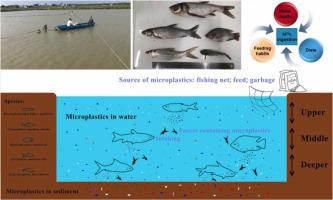Journal of Environmental Chemical Engineering ( IF 7.4 ) Pub Date : 2022-01-17 , DOI: 10.1016/j.jece.2022.107189 Zhou Aiguo 1, 2 , Sun Di 1, 2 , Wang Chong 1, 2 , Chen Yuliang 1, 2 , Xie Shaolin 1, 2 , Liu Peiqin 1, 2 , Xu Guohuan 3 , Tang Huijuan 1, 2 , Zou Jixing 1, 2

|
Microplastics have become a potential hazard to the quality and safety of aquatic products although there are few reports on microplastics distribution related to water depth, feeding habits and diets in aquaculture ponds. In this study, five aquaculture fish species (Ctenopharyngodon idella, Hypophthalmichthys molitrix, Cirrhinus molitorella, Oreochromis niloticus and Pelteobagrus fulvidraco) were selected and their accumulation of microplastics was measured and classified. We found that the water depth, feeding habits and diets led to large differences in microplastics accumulation. The bottom-dwelling omnivorous fish had the largest ingestion of microplastics and ranked as P. fulvidraco>O. niloticus>C. molitorella,the herbivore C. idella in the middle benthic layer and the upper-layer filter-feeder H. molitrix had the lowest ingestion. The detection frequency in the gastro-intestinal tracts for C. idella, H. molitrix, C. molitorella, O. niloticus, and P. fulvidraco were 93.33%, 91.67%, 87.50%, 92.86%, and 90.91%, and detection frequencies for gills were 86.67%, 100%, 87.5%, 100%, and 81.82%, respectively. Fibers presented the dominant shape (91.92%) and blue was the primary particle color in the majority of the samples (77.39%) and 0.5–2 mm particles dominated. The plastics were composed of olefins, acrylic, rayon, polyester, polyethylene and polypropylene. Our study first reported the relationship between MPs accumulation and water depth, feeding habits and diets in aquaculture ponds, which also has a certain correlation with the fish size.
中文翻译:

不同水深、摄食习性和日粮养殖鱼类微塑料摄入特点及差异
微塑料已成为对水产品质量和安全的潜在危害,尽管关于水产养殖池塘水深、摄食习惯和饮食等微塑料分布的报道很少。在这项研究中,选择了 5 种水产养殖鱼类(Ctenopharyngodon idella、Hypophthalmichthys molitrix、Cirrhinus molitorella、Oreochromis niloticus和Pelteobagrus fulvidraco ),并对其微塑料的积累进行了测量和分类。我们发现水深、摄食习惯和饮食导致微塑料积累的巨大差异。生活在海底的杂食性鱼类摄入的微塑料最多,排名为P. fulvidraco>尼罗罗非鱼> C. molitorella,中底栖层的草食性C. idella和上层滤食性H. molitrix的摄食量最低。C. idella、H. molitrix、C. molitorella、O. niloticus和P. fulvidraco在胃肠道中的检出频率为 93 。33%、91.67%、87.50%、92.86%、90.91%,对鳃的检出率分别为86.67%、100%、87.5%、100%、81.82%。纤维呈现出主要的形状 (91.92%),蓝色是大多数样品 (77.39%) 的主要颗粒颜色,0.5-2 mm 的颗粒占主导地位。塑料由烯烃、丙烯酸、人造丝、聚酯、聚乙烯和聚丙烯组成。我们的研究首先报道了养殖池中 MPs 积累与水深、摄食习性和日粮的关系,这也与鱼的大小有一定的相关性。











































 京公网安备 11010802027423号
京公网安备 11010802027423号